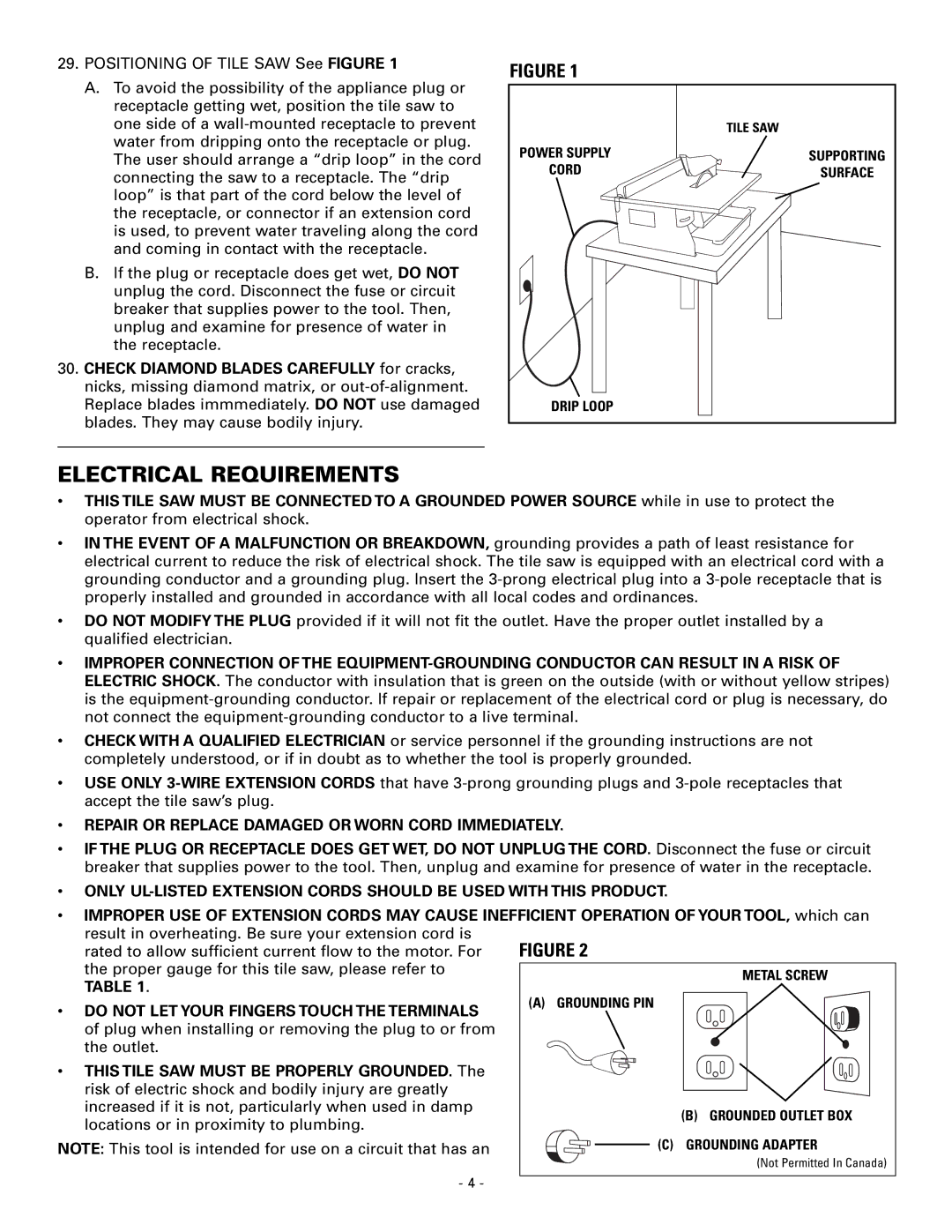
29. POSITIONING OF TILE SAW See FIGURE 1 | FIGURE 1 |
|
A. To avoid the possibility of the appliance plug or |
|
|
receptacle getting wet, position the tile saw to |
|
|
one side of a |
| TILE SAW |
water from dripping onto the receptacle or plug. | POWER SUPPLY | SUPPORTING |
The user should arrange a “drip loop” in the cord | ||
connecting the saw to a receptacle. The “drip | CORD | SURFACE |
loop” is that part of the cord below the level of |
|
|
the receptacle, or connector if an extension cord |
|
|
is used, to prevent water traveling along the cord |
|
|
and coming in contact with the receptacle. |
|
|
B. If the plug or receptacle does get wet, DO NOT |
|
|
unplug the cord. Disconnect the fuse or circuit |
|
|
breaker that supplies power to the tool. Then, |
|
|
unplug and examine for presence of water in |
|
|
the receptacle. |
|
|
30. CHECK DIAMOND BLADES CAREFULLY for cracks, |
|
|
nicks, missing diamond matrix, or |
|
|
Replace blades immmediately. DO NOT use damaged | DRIP LOOP |
|
blades. They may cause bodily injury. |
|
|
ELECTRICAL REQUIREMENTS
•THIS TILE SAW MUST BE CONNECTED TO A GROUNDED POWER SOURCE while in use to protect the operator from electrical shock.
•IN THE EVENT OF A MALFUNCTION OR BREAKDOWN, grounding provides a path of least resistance for electrical current to reduce the risk of electrical shock. The tile saw is equipped with an electrical cord with a grounding conductor and a grounding plug. Insert the
•DO NOT MODIFY THE PLUG provided if it will not fit the outlet. Have the proper outlet installed by a qualified electrician.
•IMPROPER CONNECTION OF THE
•CHECK WITH A QUALIFIED ELECTRICIAN or service personnel if the grounding instructions are not completely understood, or if in doubt as to whether the tool is properly grounded.
•USE ONLY
•REPAIR OR REPLACE DAMAGED OR WORN CORD IMMEDIATELY.
•IF THE PLUG OR RECEPTACLE DOES GET WET,DO NOT UNPLUG THE CORD. Disconnect the fuse or circuit breaker that supplies power to the tool. Then, unplug and examine for presence of water in the receptacle.
•ONLY
•IMPROPER USE OF EXTENSION CORDS MAY CAUSE INEFFICIENT OPERATION OF YOURTOOL, which can result in overheating. Be sure your extension cord is
rated to allow sufficient current flow to the motor. For the proper gauge for this tile saw, please refer to TABLE 1.
• | DO NOT LET YOUR FINGERSTOUCH THE TERMINALS | (A) GROUNDING PIN |
| ||
| of plug when installing or removing the plug to or from |
|
| the outlet. |
|
• THIS TILE SAW MUST BE PROPERLY GROUNDED. The risk of electric shock and bodily injury are greatly increased if it is not, particularly when used in damp locations or in proximity to plumbing.
NOTE: This tool is intended for use on a circuit that has an
(Not Permitted In Canada)
- 4 -
